
|
“Revisionism, the itch of historians to say something new about something already known…”
Adam Gopnik, “Finest Hours,” The New Yorker, August 30, 2010 Revisionism: Advocacy of the revision of an accepted, usually long-standing view, theory, or doctrine, especially a revision of historical events and movements. |
Starting in the mid 1970s, antiques dealers began promulgating revisionist notions about Gustav Stickley, reviving his oeuvre with infusions of modernism, innovation, and progressivism, drugs necessary to open the purses of big spenders who are slaves to collecting trends. Once high prices established credibility, museum curators followed the money and every American art museum acquired at least one example of the usually mass-produced, usually quartered oak, usually derivative, usually middle-class, usually sublimely ordinary furniture. I think the most innovative aspect of Stickley’s production is the successful modern marketing technique by which dealers have kept Stickley profitable for thirty-five years. Before their creative selling methods changed the art in decorative arts, virtuosity in craftsmanship, sumptuous materials, rarity, and even a concept of beauty based on upper-class aesthetic ideals determined an object’s value, whether it was a Duncan Phyfe curule chair or a Mies van der Rohe Barcelona chair. Among Phyfe chairs, a collector coveted the one with brass feet, carved festoons, reeding, and the best grade of Honduran mahogany. The most desired Barcelona chair was the original version that has a steel frame welded together with the care a jeweler might lavish on a gold tiara and cushions of fine leather tufted in a geometric pattern that only an extraordinarily skilled artisan could produce.

A premium was not placed on originality and innovation until the end of the twentieth century when a market for what is now called “mid-century modern” began to kindle. Once the Eames LCW chair was turned into a hot icon, earlier use of laminated wood was looked at from a different perspective. Belter’s crawling carved encrustations that had previously defined despised Victorian excess became “innovative” and even “progressive” because he layered thin sheets of rosewood to strengthen the otherwise brittle wood, which allowed him to achieve sweeping curves and extremely intricate decoration. It became more important to decide who was first rather than to discuss what was pleasing. Gustav Stickley’s clumsy table number 935 was more desirable (i.e., valuable) than L. and J. G. Stickley’s more refined “director’s table” because Gustav copied Baillie Scott first. Craftsman’s 1902 hulking, user-unfriendly number 210 settle was more desirable than Stickley Brothers’ later, gentler settle number 3863.


As the Arts and Crafts market developed, it became apparent that good Craftsman furniture was as easy to find as good examples of any of the many other brands, which capitalized on the Arts and Crafts style. Dealers needed to make one brand more valuable than its competitors, so they published pyramid-shaped lists with Gustav Stickley at the pinnacle. They disguised their price structure as an objective spiritual purity test. It would take another decade for Winterthur types to realize that the American Arts and Crafts movement was a mother lode of fresh thesis subjects, but by then the artificial hierarchy was entrenched as history, which naïve students unwittingly reinforced. Little was written in a context of aesthetics, but much was and is still made of how the virtue of simplicity slathered onto the pages of The Craftsman magazine influenced consumers all across America. Elbert Hubbard did not have a furniture factory as big as Stickley’s, but he did have propaganda publications; in his day, he and his Roycrofters were more known and loved by the general public. Roycroft designers like Dard Hunter and Karl Kipp more than matched Stickley’s Harvey Ellis and LaMont Warner. Will Price was a paragon of philosophical purity. He too had a propaganda publication he called The Artsman. He also wrote about “the structural idea” for The Craftsman. He established a Utopian community, which was far more democratic than Stickley’s Craftsman Farms would have been if it had ever got up and running, and Rose Valley furniture expressed Price’s Arts and Crafts bona fides in a way that does not require modern rationalizations about “bench made,” “batch made,” or bazillion made. Daniel Kendall had no Arts and Crafts axe to grind, but he did apply many of the “progressive” ideas associated with the movement to his designs for the Phoenix Furniture Company, the huge Grand Rapids factory. He came up with a stable green finish and he designed relief decorations that did not imitate hand carving and that were best done by machines. The Gustavites dismissed all these designers along with many more like Charles Limbert or Joseph McHugh and awarded Stickley the moral high ground. Such a measure has nothing to do with the aesthetic merit of the product. It is tantamount to declaring Duchamp’s “Nude Descending a Staircase, No. 2” to be inferior to Braque’s “Man with a Guitar” because Duchamp only dabbled in cubism while Braque devoted most of his career to it. Still, the concocted pecking order prevailed and now Gustav Stickley’s works bring tens of thousands of dollars more than those of the others.
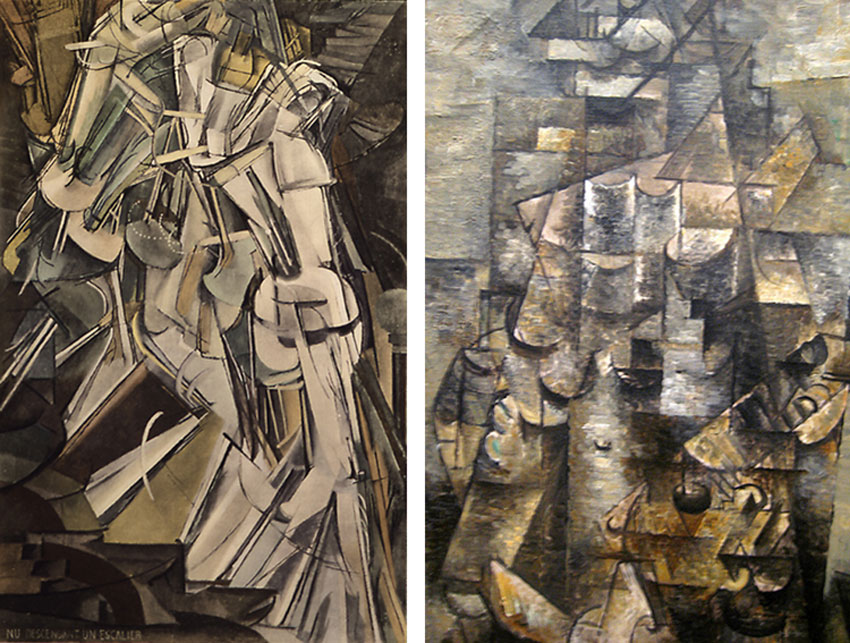
Historians narrowed their perspective to a point where Stickley’s place in the Arts and Crafts movement mattered less than documenting how often he changed his socks. Rich collectors amassed staggering amounts of Stickleyobilia while besotted researchers published more and more minutiae until a Stickley stalagmite filled the whole American Arts and Crafts cave. When a new generation of explorers arrived at the entrance, they couldn’t see around Gustav Stickley so they relied on the old prospectors to tell them what was there.
Young Dallas curator Kevin Tucker began to explore Stickley after his museum acquired a rare (“rare” rather than “unique” because a knowledgeable dealer believes he knows of an identical piece) linen chest. “Gustav Stickley and the American Arts & Crafts Movement” is the admirable result of his findings. I like the title. Without the traditional museum exhibition title colon, e.g., “Gustav Stickley: Master of the American Arts & Crafts Movement,” it offers the potential for objectivity. Stickley hasn’t enjoyed such a careful, intense presentation to the general public for many years. But Tucker’s writing style makes it seem like he drank the Kool-Aid—Gustav’s own and the juice proffered by Stickley’s latter-day acolytes— during the development of the exhibition, and the project became a paean to one part of one man’s accomplishments. It preaches to a hoary choir and will mislead the Arts and Crafts novitiate. The following is an agnostic’s view of the canonization:

“Gustav Stickley and the American Arts & Crafts Movement” premiered in Newark, New Jersey in close proximity to the Stickley Museum at Craftsman Farms in Parsippany. Though I haven’t been to the Newark Museum in years, I have always had a high regard ––based on Ulysses Grant Dietz’s long tenure as curator and champion of American decorative arts –– for the important collections housed in the 1885 Ballantine House. When I got there this time, I realized I had forgotten the odd proportions of the halls and galleries in the rest of the North Wing; despite the grand height of the ceilings, the narrow width of the spaces is claustrophobic. As I remember my recent visit, the temporary Stickley exhibition wall rose before me as I climbed a narrow flight of stone steps. The mysterious, darkly glowing exhibition entrance was framed by a heavenly light washing over color blowups of cheery cherry blossoms and lavender wisteria blossoms scanned from covers of The Craftsman magazine. The scanning process reproduced the rough texture of the original brown butcher paper cover, which gave the images a tapestry-like quality, leading one to hope for a creative, different interpretation of Stickley’s work. The Barnum & Bailey hyperbole in the handout provided by the Newark Museum dashed that hope:
“Gustav Stickley and the American Arts & Crafts Movement is the first major exhibition to focus on the career of one of the most influential figures to arise within the Arts and Crafts movement in the United States in the early 20th century.
.
With simple lines and honest construction that emphasized the craft of their makers, Stickley’s products evoked a romantic, pre-industrial world while simultaneously embracing a progressive, distinctively American style.
.
This exhibition includes more than 100 of the most important works by Stickley’s designers and workshops—furniture, metalwork, lighting, textiles and architectural plans. Never before seen together, all are masterworks from private collections and museums across the nation.”
•“Simple lines” are not a distinctive, “progressive” trait of Stickley’s products, of the Arts and Crafts movement in general, or of “American style.” “Honest construction,” such as it existed at all, did not emphasize the “craft” of Stickley’s factory workers, who only executed designs exactly as dictated by the plans handed to them—the workers had no opportunity to express individual craftsmanship.
•There are more than one hundred works in the exhibition. They have never before been seen together. They are all from private collections and museums across the nation. “Most important works”? “Masterworks”? Not so much.
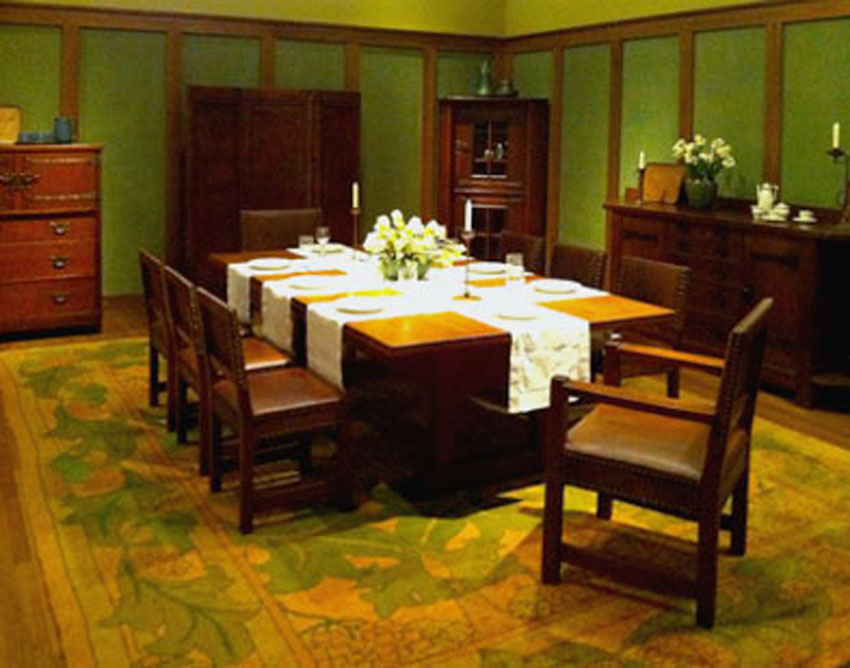
At Newark a seductive “re-creation” of the model dining room Stickley assembled for a 1903 Syracuse Arts and Crafts exhibition looms like a temple inside the entrance. There is an assumption of accuracy inherent in the idea of such a re-creation so, as my eyes adjusted to the dim light and I kneeled before the display in order to read the low-placed labels, I didn’t notice how much truthiness influenced my first impression. The spacious dimensions of the “room,” the rich colors, the marvelous furnishings, and the pretty yellow tulips made me forget that the installation was a propaganda tool for Stickley and Tucker that is many times removed from the way real people lived with Arts and Crafts furnishings at the turn of the last century. Few, if any, middle-class people had bungalows (Craftsman or otherwise) with dining rooms as grand as the model room. Fewer still furnished their homes with Craftsman furnishings only, and no one had these unique custom-made objects or out-of-season flowers arranged in tight–twenty-first-century bunches. The table used in the re-creation is not the table used in the original model room. To my way of thinking, this is significant because, even if the designs of both tables copy British precedent, the one used at Newark looks much more “innovative” and “progressive.” The oddest thing about the model room is Tucker’s contention that it “not only served to recognize Stickley’s success as a maker of furniture, but also reinforced his status as a central figure in the dissemination to the American public of Arts and Crafts design and its accompanying ideology celebrating labor, nature, and simplicity.” Stickley and his team created the room. Can Stickley award himself with success and status with the American public and the whole Arts and Crafts movement?

The re-created model room provides no context for Stickley in the larger world of Arts and Crafts or the smaller world of his own oeuvre, but it does set the stage for the revisionist take of the rest of the exhibition—the run-of-the-mill objects that were featured in the 1972 Princeton show as being representative of Stickley’s best intentions were replaced with exotic, often unique pieces. The next thing I saw was a group of ash furniture that, according to the label, retains its original green finish. If this were so, the dim gallery lighting rendered the color invisible. Even the tops of the tables, where one would expect to see some evidence of wear, appear to be incredibly even in tone and gloss. Photographs in the book, which goes along with the exhibition, are a little more revealing: The green is slightly more evident and the photograph of catalogue number 15 shows where the finish has been reworked (at very least) around the tenons and pins.
A text panel on the wall discusses Stickley’s early experiences in his uncle’s furniture factory, giving the impression that the exhibit will be chronological––but there is, in fact, no concept development in the Newark installation. Even though each “alcove” is tastefully arranged, the cumulative effect on me was a too large group of gorgeous objects jammed willy-nilly into a too small space. Inlaid furniture is given undue importance with an alcove all its own, while some children’s furniture, a rare grand (if prosaic) table lamp and a pair of equally rare, grand, prosaic andirons are relegated to what seems like a service corridor. Rare and wonderful textiles take up a so much exhibition space that an explanation of their importance is expected but not found. As one who is somewhat familiar with the American Arts and Crafts movement, I was at a loss to understand the point of the exhibit; I wonder what the casual observer who wanders in off the streets of Newark will be able to make of it. Neophytes looking at earlier exhibitions, which included Stickley furniture like his 1907 number 218 settee used in the Princeton show, could at least identify with something they had seen in their grandmother’s attic or barn. That kind of unremarkable oak furniture may not warrant exhibition in art museums, but it made up more than 90% of Stickley’s production because he had to appeal to an unsophisticated audience, which was often unaware of the elitist version of simplicity espoused in The Craftsman and who would never consciously choose to live the “simple life.”
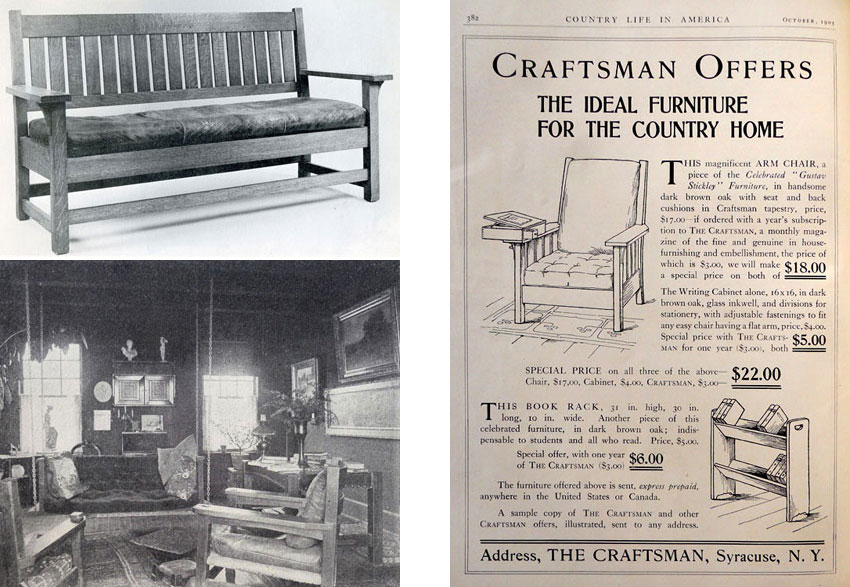
None of Stickley’s vaunted reform ideas are evident in a 1903 Country Life in America advertisement unless one sees them in the use of the terms “ideal furniture” and “genuine.” The desperate (quotes around Gustav Stickley to prove that the name had been published elsewhere) copy is ludicrous, but it must be the kind of documentation used to support the Dallas assertion that Stickley Craftsman furniture was popular: “This magnificent ARM CHAIR, a piece of the Celebrated ‘Gustav Stickley’ Furniture, in handsome dark brown oak with seat and back cushions in Craftsman tapestry, price, $17.00—if ordered with a year’s subscription to THE CRAFTSMAN, a monthly magazine of the fine and genuine in house furnishings and embellishment…” The “magnificent” chair in the ad and a photograph showing an Eastwood chair in an interior that uses late-Victorian elements to achieve an Arts and Crafts look support Princeton’s 1972 version of Stickley as exemplified by the mission-oak settle exhibited. “Ideal furniture for the country home” implies that there might be a second city home, where Craftsman furniture might not be so ideal.

Tucker is challenged by dichotomies in Stickley’s expression of Arts and Crafts movement philosophy. Curator and craftsman seem willing to equate simplicity with beauty, which pretty much puts a Fabergé egg out of the running. Stickley and the Arts and Crafts movement claimed they wanted people to find their own way to the simple (beautiful) life, yet, had he been successful, Stickley would have standardized life in the same way Martha Stewart did at the height of her popularity, although I must acknowledge a quantitative difference between promotion of Grueby green through The Craftsman magazine and saturation of Araucana green through Martha Stewart Living Omnimedia, Inc.
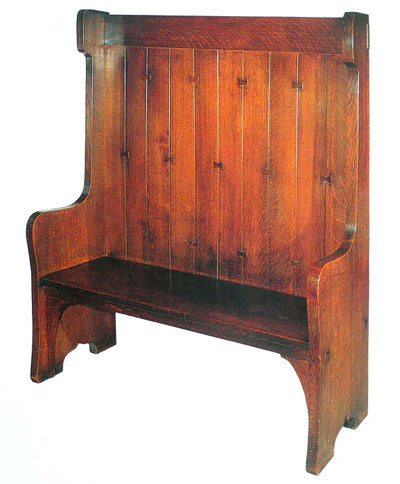
The Dallas show emphasis on unique or rare Craftsman designs validates the hundreds of thousands of dollars museums and collectors spent on Craftsman furniture. It may also explain why these designs have ended up on pedestals in art museums, but it does not explain Stickley’s place in America during the years between 1900 and 1913. Although it does not show on the floor plans of Stickley’s Syracuse home as drawn for The Craftsman, this bench was used in the foyer. Grandson Peter Wiles pointed out scratches that were visible in 1979 and claimed that they were made when he put his ice skates up on the seat to tie their laces. A similar, much longer settle used in the Syracuse dining room alcove proved unstable when subjected to modern central heating—the butterfly joints would shoot across the room like bullets when the back boards contracted. Of course these are also unique pieces, but the story of their use and abuse contributes to a cultural context. Provenance contributes more context: We used to find settles and chairs like the ones used in the 1972 Princeton exhibit in New England American Legion halls, in hotels like the old Poland Springs House, or on the porches of rural farms, but we seldom found “Ellis” inlaid furniture in such places.
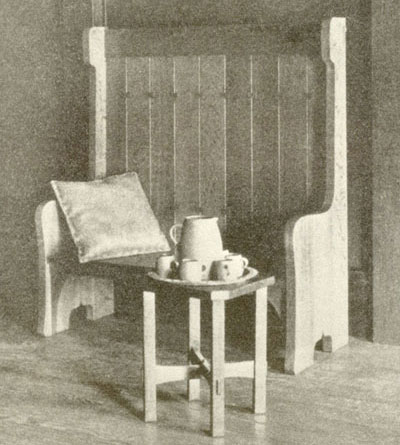

All the Craftsman elements of interior design the McPheresons find in Stickley’s Syracuse house were present in the 1897 edition of Will Price’s Model Houses for Little Money. The rustic cabin appeared in the 1904 edition, so it might have been added to make the book competitive with the myriad house plan books being offered in periodicals like House Beautiful and American Country Life.
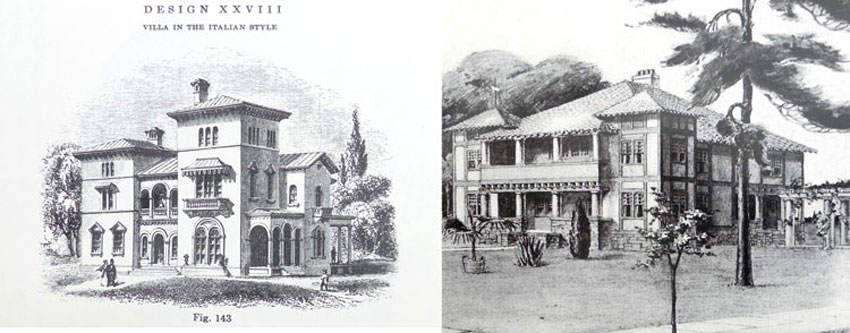
Authors McPherson think Stickley and his designers recognized that they had created an American style of furniture within two years of the completion of the interiors for his first Syracuse house and that they soon provoked the envy of Tobey Furniture Company’s George Clingman:
“The trouble with Stickley and his followers is that they expect the furniture most suited to a modest $5,000 home to serve in the mansion of a millionaire. It is not possible to make all houses conform to a common standard. The furnishing of every house should be in some measure the reflex of the character and means of the occupant. I grant you there is much that is satisfying in the plain surfaces and the straight lines, but, even of these there must be more or less satisfaction if we use them everywhere and under all conditions.”

George Clingman’s wise observations about the incompatibility between mansions and Craftsman furniture is vividly illustrated in the Circassian walnut, red damask-lined library of Daniel Guggenheim’s summer home as pictured in a 1909 American Homes and Gardens magazine. The rest of the house and gardens is luxuriously simple in a way that is “convenient, harmonious, and related in all its parts.” I suppose Mr. Guggenheim thought the library was also harmonious, but I agree with Mr. Clingman.
The biased premise that the renovations of Stickley’s Syracuse home magically produced an American style assumes the designs of the elements of its interior were original to the “design team” and were not already in use among American householders. My studies convince me that many householders updated their late-nineteenth-century houses or apartments by slip covering the interiors with Arts and Crafts detailing. Now famous examples that come to mind are Charles and Anna Rohlfs at their house on Norwood Avenue in Buffalo and John Scott Bradstreet at his Minneapolis Craftshouse. None of these interiors codified an American style except in as much as they were made in America.
As far as I know, no one has yet demonstrated that “the appeal [of early Craftsman furniture] to a broader audience was successful” or that that success provoked envy. Clingman’s measured, presciently wise critique precisely identifies limitations, which would lead to the demise of Craftsman furniture.
I can’t understand why the gals writing about Arts and Crafts architecture insist it all started on the west coast. Following Wendy Kaplan’s, Cheryl Robertson’s, and Leslie Freudenheim’s lead, Beverly Brandt writes, “Though The Craftsman illustrated bungalows suitable for nearly every region of the United States, most were being built on the west coast with the result that many articles began referring to the ‘California bungalow’” as a specific type.” Could it be merely that “California bungalows” and all the other types of bungalows, which were being built and still stand on the East Coast, are salted among a couple of centuries worth of house styles where they are not so visible as those put up chock-a-block in then-relatively unbuilt California? Anyway there’s no such thing as “most” Craftsman bungalows since not a lot of Craftsman houses—bungalows or otherwise––were built anywhere. While the tone of most of the writing for the exhibition is worshipful, Brandt hides a possibly heretical view by posing questions. She wonders, “Was the colonial bungalow the ultimate expression of the Craftsman home’s adaptability, or was it a travesty, a contradiction of the innovation that the magazine claimed to promote?” She is clever enough not to answer the question, but I will tell you the bungalow in question is a travesty even though it embodies all the redeeming virtues espoused by The Craftsman, which another essayist calls “the bible for the new religion of design.” The exhibition was put together by an art museum yet aesthetic judgments about Stickley’s work are carefully avoided. Aesthetic judgments are, however, used liberally to impute sin to all work around him. In extolling Harvey Ellis’s guiding principle “to balance the practical with the artistic,” Brandt writes, “He stresses that the house ‘shall be convenient, harmonious, and related in all its parts.’ Such qualities—the antithesis of the late-Victorian hodgepodge—were the desiderata of design reformers.” Had she dropped the article “the”, she might have avoided condemning an entire era. There can be hodgepodge within any era or style (the hodgepodge of The Craftsman “colonial bungalow”), but there were also late-Victorian homes that were “convenient, harmonious, and related in all [their] parts.”
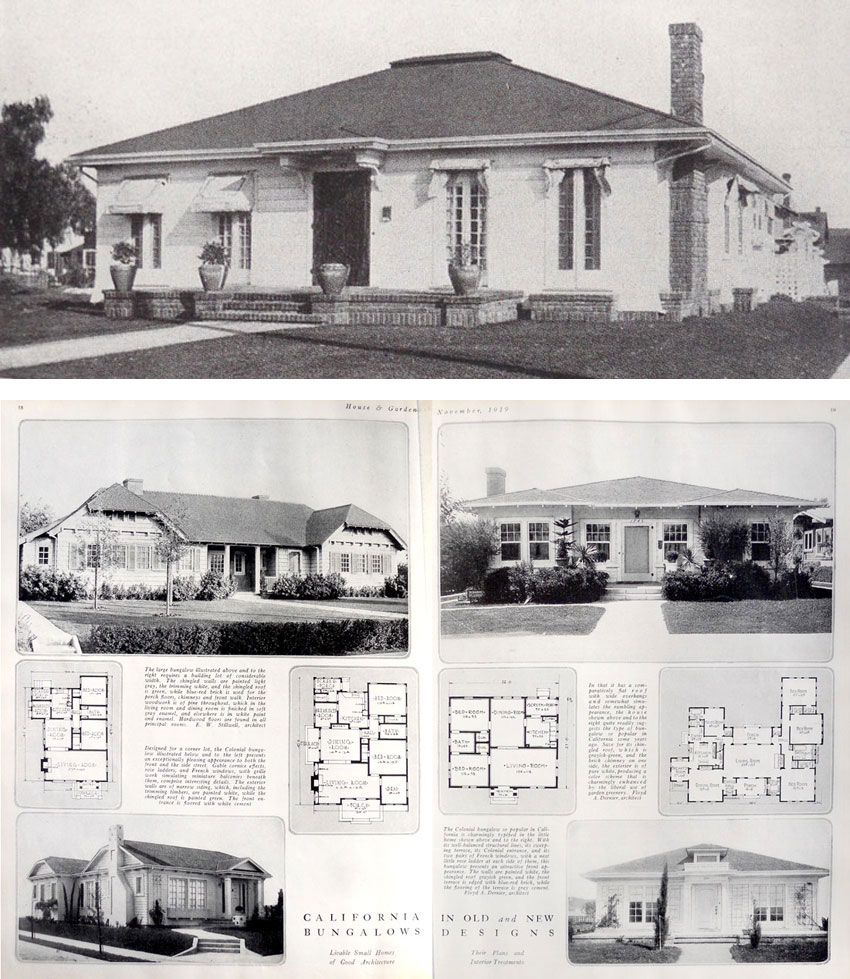
One reason the Craftsman California Colonial Bungalow is not “architecturally good” might be that the many sets of French doors set into the façade do not reveal the plan of the interior—their silly, dangerous brick “balconies” are another reason the design is a travesty. However, Stickley’s designers were far from the only ones confused about what “California,” “colonial,” or even “bungalow” meant: All the California houses on the two-page spread in a 1919 House and Garden are said to be “Colonial” referring to the New England style and not Spanish Colonial. Two of them also have that salient colonial detail, the French door. The “representative California Bungalow” in the 1911 House Beautiful ad has two full stories and a flat roof that get it only as far west as the Prairie School.

The formula for getting simplicity to equal beauty requires simplistic, reductive depictions of styles. Brandt finds skepticism in Craftsman reports about Art Nouveau evidently forgetting that the often-overwrought style could be as elegantly simple as the Colonna china and chairs illustrated in the pages of Stickley’s magazine. Tucker uses the term “new furniture” as if it were coined by Stickley to designate his earliest designs. In fact, “new furniture” and “new art” constituted the American furniture industry’s take on Art Nouveau—the terms were in wide use particularly at firms like Tobey where Stickley’s “Nancy school” pansy tables were first introduced.
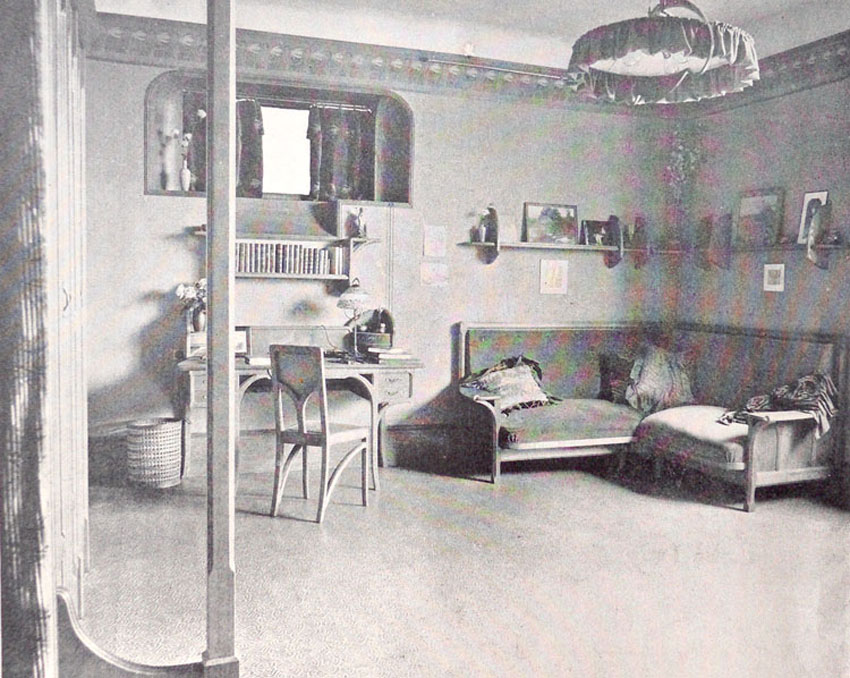
Primary source material usually offers the most objective picture of the American Arts and Crafts movement, but it is not always easy to interpret using subjective modern rhetoric: A studio by Maurice Dufrène was published in a 1911 Arts and Decoration. The French Art Nouveau room is “convenient, harmonious, and related in all its parts.” The woodwork and built-in furniture have a “natural” finish that shows the grain of the wood. The sweeping curves of the chair stretchers are modern, simple, and adhere to the “structural idea.” The Craftsman-style bungalow dining room was published in a 1911 American Homes and Gardens. Its “simple lines and honest construction” embrace “a progressive, distinctively American style,” yet the magazine characterizes the built-in buffet as Art Nouveau.

The eye of the beholder seldom sees incontrovertible truth. Sally-Anne Huxtable sees the legs of the “Foxglove Tabouret” as having “the long thimble shape of the flower’s profile.” When I compare a real foxglove flower to the table leg, I see no such similar profiles. Tucker sees these tables as less florid than “the more lavishly carved and inlaid Art Nouveau work of Nancy’s leading furniture makers Émile Gallé and Louis Majorelle,” again using the “the” to inaccurately color all French Art Nouveau. I think too much is being made of these tables; if they weren’t Stickley, they would be ignored as flimsy, hackneyed designs suitable only for the late-Victorian hodgepodge. David Cathers attempts to straighten out the sinuous lines of an amateur’s decorations on a tabouret by writing away what my eye sees: “The repeated floral pattern of each panel is symmetrical, with stiff conventionalized poppies, spade-shaped buds, and stems contrasting with the textured, hand-carved ground.” I see nondescript flowers set upon snake-like stems that further animate the already writhing background carved into the wavy wood grain, which appears to have been emphasized by a treatment John Scott Bradstreet called “jin-di-sugi.” The lively result is such a successful enhancement that the same model without Art Nouveau pyrographic embellishments should have been selected for an exhibition about Stickley products—the amateur issue is way beyond the scope of this project.

Sally-Ann Huxtable credits a foxglove flower for the shape of the legs of a Craftsman table, but the inspiration for the Doge’s Palace in Venice has not previously been credited to Gustav Stickley.
What consumers did with Craftsman products once they got them home and how owners of Craftsman houses furnished them is a subject worthy of an exhibition although it probably couldn’t get into an art museum. I have seen many pieces of Craftsman furniture “improved” with pyrography or other amateur handiwork. One lady I visited had a monumentally simple trestle table that her late husband had made cozy by carving a swirling paisley pattern into the top. She also had an early Craftsman sideboard with brass hardware that I’d never seen before and haven’t seen since. She cherished the furniture for what she thought it was supposed to mean, but she saw no philosophical dichotomy in regularly polishing the battleaxe-shaped escutcheons to a brilliant golden shine. Thirty-five years ago I was horrified; now I would say, “You go, girl!” Another lady living in a modest colonial-style house on Long Island got the whole Arts and Crafts simplicity shtick exactly as Ellis dictated. All the woodwork was unpainted and unvarnished. She had made portieres from nineteenth-century hand-woven blue and white coverlets recommended, not by The Craftsman, but by more widely read House Beautiful as representing the simple life enjoyed by colonial householders. Simple, quartered-oak Stickley furnished the dining room. Here’s the kicker: The Stickley was late, poorly made Hepplewhite-style furniture with veneer and string inlay and no apparent structural integrity. Nobody today wants to acknowledge that this stuff even existed let alone that it is just as “convenient, harmonious, and related in all its parts” as the furniture in the model dining room.
Tucker is like the little old Long Island lady in that he sees what he expects to see. In the case of the “Chalet Table” (catalogue number 12), he sees a “radically simple” table that “eschewed constructive decoration to create a geometrically precise object that appears to suggest a prescient modernity.” The modernity suggested to me is that the table would be more logical were it made of molded plastic or welded steel because the lack of “constructive decoration” makes it look like it shouldn’t stand up at all. After pages and pages of extolling Stickley’s (perhaps more accurately Will Price’s) structural idea, Tucker chases his tail rationalizing the ways this dramatic table doesn’t measure up to Arts and Crafts standards. He guesses that the name “chalet” might have been chosen because “The architecture [of Swiss cottages] does not conceal the materials and methods of construction used.” While recognizing the table has none of a chalet’s structural integrity, he asserts that the table “presages” Stickley’s articulation of his approach to structure and function, so “the design shall represent, and not confuse the structural idea; in a word, that our art shall not conceal our article [italics in the original].” Even with the original italics, I’m confused about what this article is supposed to represent [italics mine].

The advertisement for chalet-style houses appears on the back of a 1913 Arts and Decoration page with an advertisement for Craftsman Furniture featuring a portrait of Gustav Stickley—not what you’d expect of “architecture [that] does not conceal the materials and methods of construction used,” which relates to the “prescient modernity” of Stickley’s “geometrically precise,” “radically simple” chalet table.

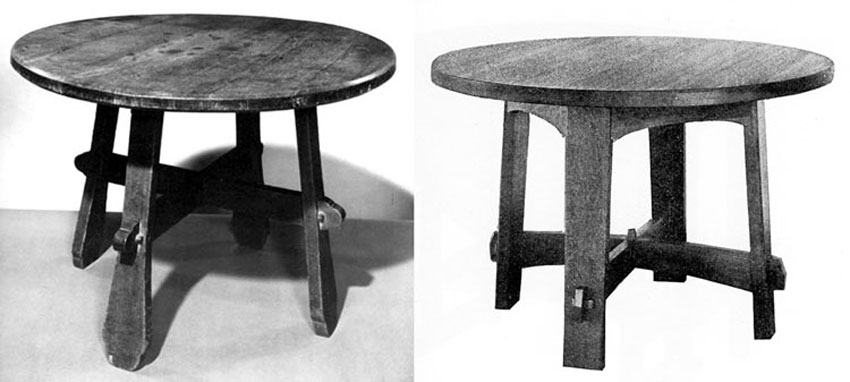
One need only to consider the G. E. Street table designed around 1854 for Cuddesdon College, Oxford, England to see how Stickley’s 1901 “Bungalow Table” (catalogue number 15) presents a problem for those who like to think of Stickley as progressive or innovative.
Tucker thanks a Dr. Barnes for cluing him in about the wide use of fumed oak in the American furniture industry—perhaps he could have learned more if the doctor hadn’t skipped out on the project. Tucker believes Stickley chose to use quartered oak to escape the common association with inexpensive, cheaply made, highly polished, “golden oak” furniture apparently unaware that golden oak could be and often was quartered and fumed. A. H. Davenport made expensive, highly polished furniture from golden quartered oak. Ignoring the many colorful stains developed by the afore-mentioned Kendall, Tucker writes, “Stickley’s factory records suggest far more complexity and experimentation in color schemes and finishes than remains today—and in comparison with that of his contemporaries producing Mission furniture.” See what I mean about judgments? Stickley produced complex, experimental Arts and Crafts furniture while his contemporaries produced mere Mission furniture.

A. H. Davenport golden, quartersawn oak that is “convenient, harmonious, and related in all its parts” despite the hand-carved embellishments that the authors of the Stickley book would eschew because Davenport did not reject “surface ornament in favor of presenting form honestly in the service of beauty.”
Another solipsistic doctor (who also pulled out early) exacerbates the misunderstanding about oak: “[Irene] Sargent’s explications of Stickley’s goals established as doctrines the anti-ornamental, rectilinear style of his furniture and the use of oak and other humbler woods rather than finer materials.” Oak was never not fine.
But oak is coming to its own again. It is bound to. Not only in the cheap golden-oak furniture and in the solid mission and craftsman styles, but in simple wax finishes that leave it stand on its own merits. It is in improved methods of finish, in fact, that its salvation lies. Whether carved or plain, whether fumed or silvered. Whether dull or highly polished, it is beautiful, and in the best antique finishes it surpasses all other woods for library and dining room.
American white oak is a hard, durable, strong wood, which, when quarter-sawed, shows a wavy cross grain that is peculiar to the wood and exceedingly beautiful. To cover this grain with a dark stain is to hide much of its beauty. But white oak is not naturally beautiful in color and we cannot wait for the mellowing effects of age. The fumes of ammonia are therefore resorted to, which, entering the dark pores, darken the wood not merely on the surface but to a considerable depth. A filler may be applied, for the grain of oak is coarse and needs it, and a French polish may be given as a final finish. The dull wax finish, however, is what is making oak popular again. This produces a durable surface to withstand the wear of usage, and yet leaves it in nearly its natural condition. With the occasional application of a little wax and elbow grease oak furniture thus finished will last for generations.
Walter A. Dyer “A Plea For Oak; The Foremost American Wood in Quality and Beauty of Grain;” Arts and Decoration, December 1910
For centuries, oak was used for all grades of cabinetmaking in much of the world; on the other hand, cabinetmakers supplying the finest furniture to rich Americans seldom used curly maple. However, rural craftsmen like the Dunlap family of New Hampshire made use of it for furnishing local homes with glorious results. The surface of a solid curly maple board has a rippled texture caused by the same pattern of hard and soft wood that gives it a fiery color contrast. In the sense that it was not considered to be a high-class wood, I suppose Stickley’s use of it is in accordance with his democratic ideals. In every other sense, Craftsman curly maple is abysmal. Although you’d never realize it from the long catalogue entry for catalogue number 53, much of the chest of drawers is covered with a thin, cheap, lifeless veneer, which negates everything the book says Stickley stood for. I, as a lover of Federal furniture, have nothing against veneer and I think the design of the chest and the other pieces related to it is handsome even if it is not appropriate for Stickley propaganda. But if we’re going to pretend Craftsman furniture is essentially hand-made and that visible handcraftsmanship is important, we can’t gin up virtue in this piece.

The drawer on the left is from a “silver gray maple” chest like the one in the exhibit. It is a “cheaply decorative production” if ever I saw one, having a plywood bottom and a lifeless veneer that is too thin to withstand even normal wear and tear. The detail on the right is from a homemade chair (“Art That Is Life,” 1987, MFA,B page 382) constructed from solid curly maple with a robust pattern and a vivid, flame-like color.
The book has a catalogue section and a section called “Notes on the Catalogue” and a checklist of the exhibition, which thwart its function and utility. The catalogue section has lavish, out-of-numerical-order, full-page color photographs of some of the objects in the show. Some objects rate multiple photographs and long text descriptions while others have the same minimal notations as the numerically ordered checklist. The “Notes on the Catalogue” are tied to page numbers, not catalogue numbers; there are no notes for many objects. The Dallas linen chest gets four pages of analysis and photographs with copious notes while a curtain panel gets just two pictures with no analysis or notes and a reclining chair gets one photo and half a page of text and four notes. Hodgepodge? A sketchy provenance is given in the checklist for a few objects—primarily the model dining room pieces––but not for most. I wanted to know more about the extraordinary curtain panel (catalogue number 88, pages 208 and 209) because the very sophisticated design is so like Prairie School-style designs such as the rugs George Mann Niedecken designed for Frank Lloyd Wright’s Bogk house. Although the border is very similar to a design published in a 1908 Craftsman, the technique and central design are not at all typical of Craftsman darned net curtains, yet there is nothing to tell why the panel was not made by one of the other artisans who produced darned curtains identical to and indistinguishable from Stickley’s. Perhaps newbie Tucker subscribes to the “Don’t ask, don’t tell” rule, but we old-timers could tell the provenance of many pieces and that provenance is itself telling.

The darned net curtain in the center has no identifying mark, but it came from the Louise Stickley estate sale so it is reasonable to attribute it to Gustav Stickley’s Craftsman enterprise. Without such a provenance, I don’t think curtains like these can be attributed to a specific maker.
A detailed provenance might answer some of the questions Tucker stops short of asking. He decides the exposed laminations on the Eastwood chair exhibited suggest “the inevitability of slight variations in an essentially handmade object.” Will Price abhorred the use of such laminations to achieve unnecessarily gigantic proportions. Referring to a dining table much like some Craftsman extension tables, he wrote, “This central leg would if solid safely hold twenty tons… It is just as bad construction to use too much wood as too little.”

Stickley usually faked solid wood by covering laminations with veneer. Back in the day when I kept an inventory of early Stickley, I was often frustrated by those veneers, which didn’t hold up well especially where they got a lot of use. We found great early pieces spoiled by chips and cracks to the veneer, which were difficult to repair and disguise. One option was to replace the whole strip of veneer and severely compromise the value of the object. Another option was to remove the veneer, refinish the exposed laminations, and market the result as “slight variations in an essentially handmade object.” We chose the former; more venal dealers chose the latter. I couldn’t study the reclining chair (catalogue number 32) in the exhibition, but in the book, it looks as if the fronts of the front legs still retain the original veneer. If they do, it is quite likely that the mismatched laminations on the sides of the legs would also have been covered with veneer to give the appearance of solid pieces of wood. Provenance could tell the truth.

The laminated legs on this Gustav Stickley library table have been disguised with panels of quarted-oak veneer. The circular detail shows how the veneer cracks along the lamination joints beneath when they expand or contract from changes in air temperature and humidity. L. & J. G. Stickley devised a more stable system for using small cuts of wood to glue up large legs.
Books like this are usually edited by people who can get most of the grammar right, but who have no expertise in decorative arts, which leaves content with the potential to embarrass the authors and confound the reader. By my count, Dallas director Bonnie Pitman tries four times within two paragraphs to describe Stickley’s importance and still gets it wrong:
“In seeking to encourage a national shift in taste away from cheaply decorative production toward radically bold, structural designs, Stickley stood both as businessman and proselytizer—and his has become one of the most familiar names associated with the American Arts and Crafts movement.”
I’m not sure I can visualize something that is “cheaply decorative” but if it existed, I am sure the part of the nation that could afford taste had a taste for expensively decorative production as well. Stickley’s vision was larger than seeking to shift taste toward the radically bold and structural aspects of his designs; he wanted to show Americans how to make or find new or old household furnishings imbued with a specific kind of simplicity that could transform everyday living into a beautiful experience. There’s nothing radically bold or structural about a hand-hammered copper tray.
David Cathers knows more about Gustav Stickley than anyone alive, but when it comes to putting the Craftsman furniture enterprise into a larger social context, he also gets the equation wrong. Explaining why Stickley focused on the middle-class market, he writes,
“This is not surprising: Working-class people couldn’t afford such furniture and the wealthy continued to prefer ostentation.”
Many wealthy people are ostentatious, but that does not mean the upper class prefers ostentation or that the middle class isn’t just as prone to ostentation: A Marshall Field ad for United Crafts furniture in the December 1902 issue of The House Beautiful offers a chair finished in “Baronial Oak!”
The difficulty of unknotting some of Tucker’s sentences can cause a reader to lose his line of thought:
“However, as his brother Albert’s firm maintained in London, Stickley did not have a commercial presence in Great Britain”—a simple fact turned into a cheaply decorative production.
“Within the span of a dozen years, his employees created hundreds of creative new designs for furniture, metalware, lighting, and textiles; designs for more than 250 homes that were constructed across the United States; and, through articles and other contributions to The Craftsman, undoubtedly influenced the design of countless others.”
Okay, “created creative new designs” was easy but still fun, right? Now for the hard part: Were more than 250 homes built across the United States from the creative designs Stickley’s designers created or did they create more than 250 different creative house plans, which were used to build a few houses located in every part of the United States? Did house designs published in The Craftsman influence countless other house designs or did the creative new designs for furniture, metalware, lighting, textiles, and homes influence countless other designs for furniture, metalware, lighting, textiles, and homes or did Stickley’s designers influence the design work of countless other designers?

.
“‘The Simple Structural Style of Household Furniture is associated throughout the country with the name Gustav Stickley. The Productions of his workshops embody the principles of the new art which is now developing among us and which promises a long and vigorous existence.’ The principles may be summarized as:
.
the predominance of the constructive idea
the absence of applied ornament
the fitness of the work to the idea
.
By the first is meant that the purpose for which an object is intended is easily deduced from the appearance of the object, in much the same way as an architecturally good building reveals in its façade the plan of the interior. The second principle is scarcely less important than the first and proceeds from it: any decoration that disguises or impairs the structural features of an object should not be used at all. The third principle dictates that choices of color, texture, and substance be made in the interests of beauty, without regard to the intrinsic value of the material employed.”
.
This three-layered analysis (quote, summarization, and interpretation) depends on the McPhersons’ highly subjective definition of “the principles of the new art, which is now developing among us.” Their summarization requires that “the principles of the new art” refer to Stickley’s new art and that the “us” in “developing among us” refer to Stickley’s design team. The mere capitalization of “The Simple Structural Style of Household Furniture” in a promotional brochure may hope to, but does not establish Stickley’s name and style throughout the country. I can easily believe “the new art” refers to an existing style and that “us” refers to Americans in general.
.
I can’t tell if the McPhersons’ break down of principles is what they believe Stickley believed, but I am sure that “architecturally good” is their personal opinion, which trashes the Pyramids, the Doge’s Palace, The Glessner House, and Walt Disney Hall among many other buildings with façades that do not reveal interior plans.
.
All decorative arts from the world over and for all time before and after Stickley would have to be burned to eliminate any decoration that disguises or impairs structural features.

The Amber Room in the Catherine Palace in Russia is a result of “choices of color, texture,
and substance made in the interests of beauty.”
The conclusion of “Gustav Stickley at Home” lists ways art historians “usually examine” objects including “… any other available measure. Yet they rarely examine objects in the context of interior design.” The context of interior design is most certainly an “available measure” frequently used by art historians. The McPhersons believe few objects can be both functional and works of art in the way Craftsman furniture can be. They go further: “It is extraordinary that the efforts of the Craftsman design team provide some of the earliest successful examples of furniture intended to fill both roles.” I don’t know to what extent Stickley intended to make works of art; I do know that the list of designers who made successful artistic, functional furniture long before Stickley’s team designed their first chair is too long to include here. Attempting to make Stickley the artistic peer of Michelangelo diminishes his actual accomplishments as a furniture maker.
I am sentimental about these grandiose books in the same way I wish the court of the Sun King or the last Czar could still exist as a fabulous artifact without social impact, but I’m afraid Gustav Stickley and the American Arts & Crafts Movement and Queen Elizabeth II may be the last of their kind—the digital revolution allows the show to go on without them just as surely as the industrial revolution allowed Stickley to encourage a shift in national taste.
The expensive, hardcover book does not function as a catalogue for the exhibition and will not have a useful life as a reference book stashed on a library shelf. But, when considered with the recreated model dining room, it does suggest that lavish amounts of time and money were spent to aggrandize the Dallas museum’s linen chest, which is given more space than any other individual object in the book. I’m no altruist, yet I found myself wondering how much more society might have benefited if the hard-to-come-by millions had been spent on an art museum in Haiti, Iraq, or even Biloxi, Mississippi instead of on this magnificent, redundant, limited view of a limited part of Stickley’s craftwork.
